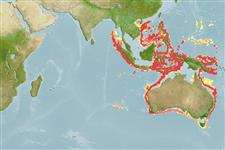Пластиножаберные (акулы и скаты) (sharks and rays) >
Squaliformes (Sleeper and dogfish sharks) >
Squalidae (Dogfish sharks)
Etymology: Squalus: Genus name from Latin 'squalus' meaning shark (Ref. 6885, 27436).
Eponymy: Whitley’s original description gives no etymology. [...] (Ref. 128868), visit book page.
More on author: Whitley.
Environment: milieu / climate zone / depth range / distribution range
экология
морской батидемерсальный; пределы глубины 154 - 1370 m (Ref. 58048), usually 383 - 670 m (Ref. 58441). Deep-water
Eastern Indian Ocean to Pacific: warm temperate to tropical waters; Australia to the Philippines; north to Taiwan, including Indonesia.
Size / Вес / Возраст
Maturity: Lm ? range ? - ? cm
Max length : 84.0 cm TL самец/пол неопределен; (Ref. 58441); 94.5 cm TL (female)
Краткое описание
определительные ключи | морфология | морфометрия
This large species of the ‘mitsukurii group’ is distinguished by the following set of characters: body elongate to robust, trunk depth 8.9-13.4% TL (mean 11.4% TL, n=14); snout is broadly triangular, with mouth width 1.69-2.32 (1.85) times the horizontal prenarial length; pre-first dorsal length 26.5-30.7 (29.0)% TL; pre-second dorsal length 57.6-62.8 (60.8)% TL; interdorsal space 21.7-25.9 (23.7)% TL; low raked dorsal fins; second dorsal-fin length 11.1-13.9 (12.4)% TL, height 3.4-4.6 (4.0)% TL, inner margin length 4.0-5.9 (4.8)% TL; second dorsal-fin base 15.8-21.3 (20.8) times the base of second dorsal spine; pre-pectoral length 20.8-22.9 (22.0)% TL; pelvic-caudal space 22.9-26.0 (24.0)% TL; caudal bar is almost upright, extending broadly from the caudal fork up the poster or margin of the upper lobe for about 0.6 of its length in immature specimens, upper caudal fringe forming a deep saddle along midlength of lobe; flank denticles tricuspid; monospondylous centra 41-47 (mainly 42-44), precaudal centra 79-85, total centra 105-114 (Ref. 58441).
Occurs on or near the bottom of upper continental and insular slopes. Viviparous with yolk-sac dependency; gives birth to 4-16 pups, gestation unknown. Feeds mainly on small fishes, cephalopods, and crustaceans. Usually caught by demersal longline fisheries operating in deepwater. Marketed for its meat, fins, and liver oil which has a high value (Ref. 58048).
Life cycle and mating behavior
половая зрелость | размножение | нерест | икра | Fecundity | личинки
Distinct pairing with embrace (Ref. 205).
Last, P.R., W.T. White and H. Motomura, 2007. Description of Squalus chloroculus sp. nov., a new spurdog from southern Australia, and the resurrection of S. montalbani Whitley. p. 55-69. In P.R. Last, W.T. White and J.J. Pogonoski Descriptions of new dogfishes of the genus Squalus (Squaloidea:Squalidae). CSIRO Marine and Atmospheric Research Paper No. 014. 130 p. (Ref. 58441)
Статус Красного Списка МСОП (Ref. 130435: Version 2024-2)
Угроза для людей
Harmless
Использование человеком
рыболовство: потенциальный рыбохозяйственный объект
дополнительная информация
инструменты
Специальные отчеты
Скачать в формате XML
ресурсы в Интернет
Estimates based on models
Preferred temperature (Ref.
123201): 6.6 - 11.9, mean 8.6 °C (based on 239 cells).
Phylogenetic diversity index (Ref.
82804): PD
50 = 0.5000 [Uniqueness, from 0.5 = low to 2.0 = high].
Bayesian length-weight: a=0.00347 (0.00165 - 0.00730), b=3.09 (2.92 - 3.26), in cm total length, based on LWR estimates for this Genus-body shape (Ref.
93245).
Trophic level (Ref.
69278): 4.4 ±0.4 se; based on size and trophs of closest relatives
устойчивость к внешним воздействиям (Ref.
120179): очень низкий, минимальное время удвоения популяции более 14 лет (Preliminary K or Fecundity.).
Fishing Vulnerability (Ref.
59153): High vulnerability (58 of 100).
